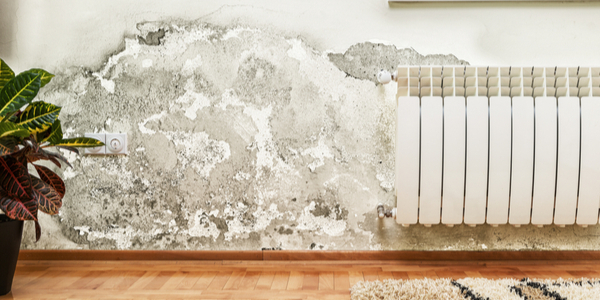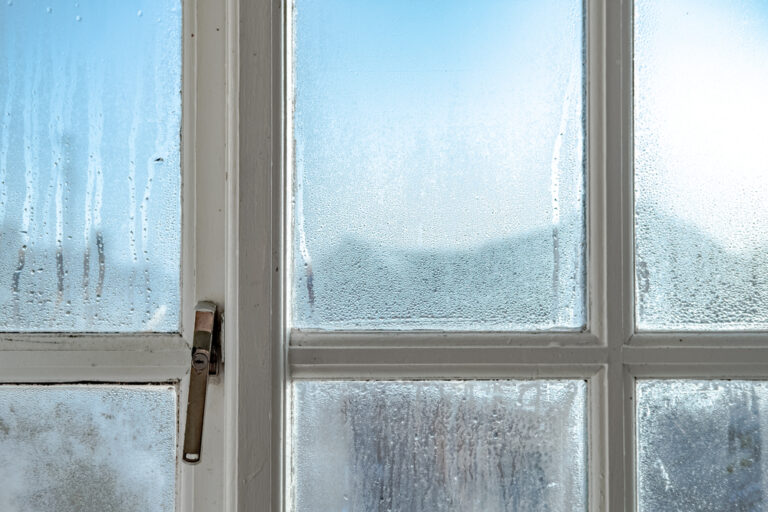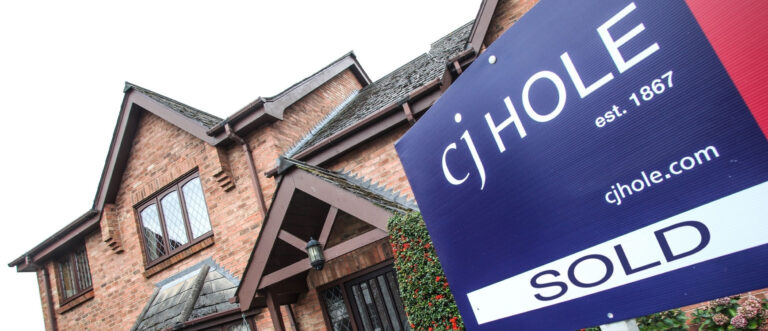Damp can do untold damage to a property and cause serious issues to its structure.
Not only that, but it’s also bad for your health and looks unsightly – something that is sure to put off potential buyers if you’re thinking of selling soon.
Landlords can often find themselves battling against damp due to tenant habits or poor maintenance of rental properties.
Here, we’ll explain the different kinds of damp, what to look out for and how you can damp proof your internal walls…
What can cause damp on an internal wall?
There are three main types of damp that can cause problems for properties:
- Rising damp
- Penetrating damp
- Condensation
Each type of damp causes different problems and can be identified by various tell-tell signs.
1. Rising damp
Rising damp occurs when moisture travels up through the walls of a property – essentially ground water being sucked up through brickwork.
Older buildings can be particularly susceptible to rising damp, which usually occurs when a property’s damp-proof course (DPC) is damaged or, in the case of very old homes, non-existent by modern standards.
In other scenarios, rising damp can be caused by things like raised driveways and paths that sit above the DPC.
Rising damp can be serious and cause structural issues if not dealt with.
It also causes damage to the internal walls, can result in heat loss and aggravate respiratory conditions.
2. Penetrating damp
Rainwater usually evaporates from brickwork on the external walls of property, but during heavy rain or in buildings where there are poorly maintained drainage pipes and guttering, rainwater that fails to evaporate is passed horizontally through external walls into the building itself.
This can cause huge problems to timber work, such as dry and wet rot, while black mould will also grow in these conditions leading to potential health problems for those living in the property.
3. Condensation
Landlords often suffer the most from condensation problems in their rental properties due to poor habits from tenants or poor ventilation in their property.
It’s the most common form of damp in the country and, probably, the easiest to eradicate, but it can also cause big problems if allowed to get out of hand, including harmful mould.
Signs of damp: What to look out for
There are key signs to look out for if you think your property has a damp problem and what you see will often tell you more about the kinds of issues you’re facing…
1. Damp patches on internal walls
If you’ve got a rising damp problem in your home, you may see horizontal brown marks on walls, and these will feel damp or cold when you touch them.
Sometimes, plastered walls will bubble and wallpaper may peel away, while mould will often be present on walls, too.
Other signs of rising damp include:
- Staining of wall coverings and blistering paint
- Damp and musty smell
- Decaying timber e.g. skirting boards, floor boards, floor joists
Rising damp can sometimes be misdiagnosed when it’s actually condensation causing the issue.
So, always call in a professional if you suspect you have a problem with rising damp, as they’ll be able to correctly identify the problem and suggest an appropriate course of action.
2. Damage to external walls
Penetrating damp can show through damage to external walls, as well as internally on walls and ceilings.
Signs of penetrating damp include:
- Damp staining on external walls
- Damp patches on walls or ceilings
- Signs of spores or black mould that are isolated to one area
- Wet and crumbly plaster
- Drips and puddles
3. Mould
All types of damp issue can cause mould.
But condensation within a property is often the biggest cause.
When warm, damp air hits a cold surface, it condenses on walls, tiles, and window frames.
This can cause mould patches, which can be extremely unhealthy for those living in the property.
How do you fix a damp internal wall?
There are various treatments and remedies available to deal with damp internal walls.
But the exact treatment you’ll need will depend on the type of damp problem you have.
Treating rising damp
Rising damp is often due to a poor, or non-existent damp-proof course (DPC).
Installation or replacement of the DPC and membrane should stop any further rising damp but is an expensive and time-consuming process.
One other way to treat and damp-proof internal walls in this case is with a damp-proofing cream which forms a protective barrier. These can be used on many different types of walls, including brick and stone.
Alternatively, a mortar can be injected into walls where it forms a crystalised barrier to stop water rising.
Treating penetrating damp
The first step in treating penetrating damp is to establish the problem area within the property’s structure that’s causing it:
- Repair defects to masonry such as cracks in walls, or doors
- Repair or replace defective guttering or downpipes
- Clean out existing pipework or guttering or leaves or detritus have blocked them
- Improve the heating and insulation within the property to eliminate cold walls
Treating condensation
Treatment for condensation usually starts at the source – people.
Areas prone to condensation are bathrooms and kitchens – where hot air clashes with cold air during the winter months and causes moisture to form on windows and walls.
Ventilation is key so air vents should never be blocked off – even if they do let cold air in.
Extractor fans in kitchens and bathrooms can also help pull warm air out of rooms when cooking or showering.
But in the main, it’s lifestyle changes that fix condensation issues long-term.
Opening a window when showering or cooking (even boiling the kettle) will allow warm air to leave the room and keep moisture levels in the property low.
Landlords should always advise their tenants on the best ways to keep condensation at bay as heavy condensation can lead to nasty black mould spores which look terrible, damage paintwork and window sealant and can cause health problems.
How much does it cost to treat damp in internal walls?
Treating rising damp can cost anywhere between a few hundred pounds to many thousands of pounds, depending on the severity of the problem and the work required to remedy it.
Less serious cases of condensation, meanwhile, can be much less costly to treat, with redecorating walls or tiles and cleaning away mould the biggest expenses.
How can I stop damp getting worse?
The best way to stop any damp problem getting worse is treating it quickly and effectively.
You can also take other steps to halt damp on internal walls, including:
- Open the windows and air your property regularly
- Heat every room evenly
- Make sure air can circulate freely around your property and avoid putting furniture and other items against walls
- Check pipes and guttering regularly and unblock if needed
- Check your roof for missing tiles
- Lag pipes to prevent them freezing in winter
- Maintain wooden window frames and doors
- Use extractor fans or open windows when cooking or bathing / showering





